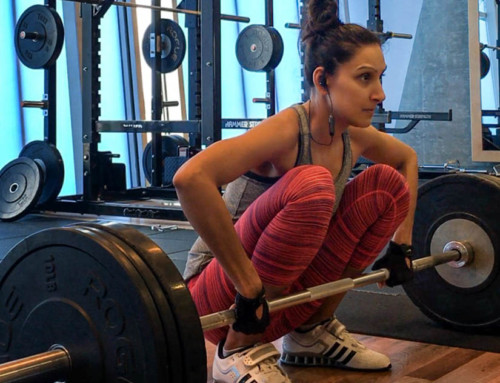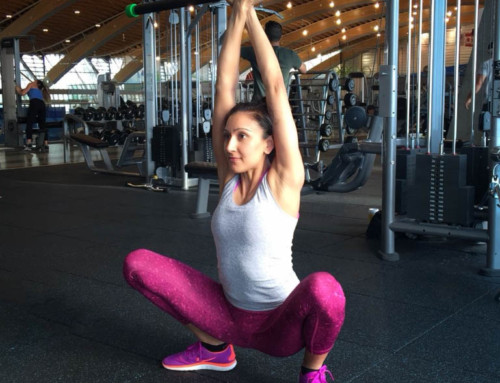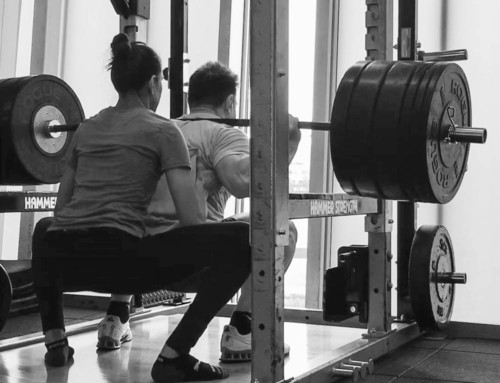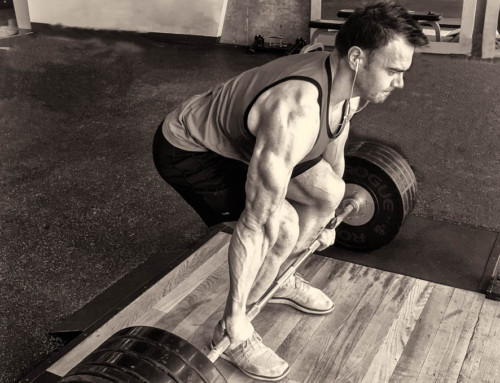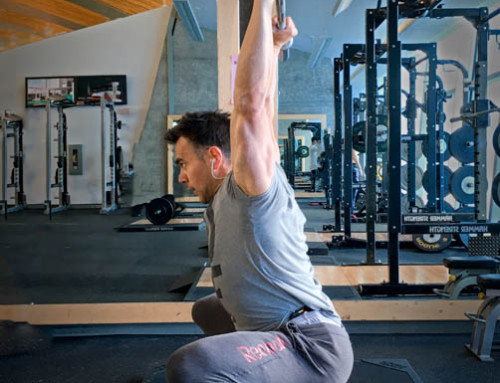Many often ask, what is the best exercise to do in the gym? This is a loaded question as it primarily depends on what your definition of “best” is.
At Science and Strength, we measure effectiveness of the movement based on ability to engage numerous tissues and body systems. With this definition, arguably the best single physical developmental exercise that anyone can do in the gym is a deadlift.
As a species we evolved effective biomechanics to pick up all kind of things off the ground through neural patterns, muscle tone, bone and connective tissue to withstand great physical demands. This simple movement engages almost every muscle within the body, fires up the Central Nervous System (CNS) and develops an unprecedented amount of strength.
There are number of deadlift variations, each one may better compliment someone’s body shape and/or goals. At Science and Strength, we don’t believe that there is such a thing as a bad deadlift type, only a bad deadlift technique. Deadlifting versions, achieving greater overload and fixing technique are all great topics that will be discussed in future posts. The scope of this article is to talk about the deadlift version that forms one of the pillars of Stronger Leaner Faster self system—The Classic (aka Conventional) Deadlift.
Deadlift Goals
Textbooks, journals, internet and people in general have many and at times passionate views about exercising. Deadlift—being an important exercise in any strength related program—is often a hot topic amongst many. Numerous debates revolve around personal preferences, but each one has a specific purpose, or a goal. As strength is the dominant ability that primarily achieved through pulling or pushing heavy loads, several versions of the deadlift have been designed to accomplish this task.
The Science and Strength goal of Stronger Leaner Faster (SLF) is developed through improving your biomotor abilities. Though strength is one of the core values of SLF system, it’s not the only one. The S&S protocols are designed with more depth that just pure intensity. They include greater body functionality and range of motion (ROM) through attributes like mobility, flexibility, stability, improving energy systems and motor unit patterns via intra- and intermuscular coordination.
To achieve these things, the SLF system primarily focuses on Classic (aka Conventional) Deadlift with several modifications. To assist the overall progression, additional deadlift versions are also implemented including, Snatch Grip (wide grip) Classic Deadlift and the Romanian Deadlift.
The Classic Deadlift
Immediate benefits of Classic Deadlift are core engagement, leg drive and hip extension. As it is easier to tip over (moving your hips up), practicing conventional deadlift engages entire lower body to evenly develop power during the pulling motion. This is where using quadriceps in this exercise become as important as driving your hips forward. Pulling the bar by generating even power from the quads and glutes engages far more muscles throughout the lift, conditions proper biomechanics and generates neuromuscular activations that are specific to the movement.
To keep everything in place, the core is stressed to the max. The core is much more than 6-pack of abs (rectus abdominis) muscles. Acting as a stabilizer, the core comprises of the whole trunk including an abdominal wall, diaphragm, pelvic floor and spinal erectors, connecting to back lats, traps and glutes. Core is an important component within posterior chain which is activated to a greater degree throughout a classic deadlift variant.
Conventional deadlift effectively engages numerous body systems. Accumulated fatigue from this pulling motion includes: sore muscles, tingly skin sensation (due to greater CNS engagement) and depleted fuel reserves within energy systems. During recovery many of body’s internal processes jump into action and begin numerous repair and regeneration tasks. As the result, deadlifting is taxing on the body by burning tons of calories during and post training.
Deadlift Modifications
We all try to train as efficiently as possible while producing maximal effect. This is accomplished by engaging the muscle fibers (especially fast twitch fibers) within large muscle groups. The path towards fast twitch (or type II fibers) activation is through greater force production, performed through strength and explosive based training. At Science and Strength, we gradually train and build up these compound lift programs (periodization) that include power development exercises like snatch and clean and jerk. However, we also favour exercises that not only develop above mentioned skills but also have a greater “carryover effect”. This is where modifying some of the conventional deadlift towards SLF goals comes in.
The Grip
Firstly, the grip is always pronated, and not mixed (as to one pronated, one supinated). Double pronated grip creates a unilateral feeling of the bar and teaches the body that same grip whether during strength or power training phases.
Starting Position
Second, at starting position, hips are a bit lower than standard recommendation as the knees track slightly further forward, pass the elbow. As more “quad dominant” lifters, we found that these adjustments produce an even power distribution during the pull, limiting premature rise of the hips. Greater knee flexion at starting position improves ankle mobility especially Dorsi-flexion (bringing the toes towards your shins) and overall force exertion through the mid-foot. Training for better ankle mobility directly improves many lower body movements, especially if you previously suffered an injury in that area, like Victor.
The Mid-Foot
Third, the mid-foot becomes the point of lower body force development during this pull in order to accomplish the balance between the quads and the glutes/hamstrings activation. Load the upper body by bracing your core, keeping shoulders over the bar while turning the deltoids outward and attempting to place the triceps into own armpits. Producing power through mid-foot is important during initial first pull, at least until the bar passes the knees. We found that by tracking the bar along the shins through the mid-foot was the most effective method of engaging the most muscle to the deadlifting cause, while suffering no injury.
The natural tendency to pull the bar back rather than drive hips forward is an early indicator of breakdown of technique, which if uncorrected can lead to developing bad form and potential for injury. Correcting this potential bad habit, the “second modification” of further knee flexion at the start position works well. Each time, the body instinctively begins to prematurely pull the bar, the intended path changes resulting in driving the bar directly into the shins. Scraping a loaded barbell against the bony tibias (shinbones) results in impressive bleeding scrapes. As you may have noticed that Victor’s shins (in the photographs) are a testament of this pulling technique practical development.
Deadlift Variations and Benefits
Improving technique involves learning movement pattern itself, as well as identifying areas for improvement through practicing lifts (especially under tension). This is where practicing deadlifts is essential to understanding own physical parameters and to pinpoint technique break-down areas.
Many believe that deadlifts should only be done once a week for one or two sets with very few repetitions (singles to triples), otherwise you may run the risk of overtraining. We’re not sure where this “overtraining” misconception came from, but to get close to overreaching (not overtraining) territory one would need to pull extensive loads (over two and half times the bodyweight) to begin to show signs of accumulated fatigue related symptoms. Like everything in life, practice makes it perfect. No need to max out every single session in order to learn proper biomechanics. But, the internal neural patterns (CNS and associated motor unit activation) of this pulling movement will not carve themselves without continuous repetition (volume).
Depending on particular training program, it is not uncommon for Science and Strength team to deadlift twice a week. Training volume is often divided between main and accessory exercises that produces significant metabolic stress levels. Theses metabolic disturbance create body responses—adaptations that improve overall strength and CNS engagement; while building slabs of muscle, as well as an impressive core and a posterior chain along with it. Below are some of the modifications to the conventional pull used during SLF strength training methods.
Snatch Grip Deadlift
Setup for Snatch grip (aka wide grip) deadlift is practically the same as conventional, except for the grip itself and foot position (depending on preference). In this variant, the body covers the bar to a greater degree with hips slightly higher than in the conventional (clean grip) starting position. From that “more covered” position the force continues to be formed from quad / hip drive balanced manner directed through the mid-foot.
What makes Snatch grip different is the noticeable engagement of the upper and mid-back muscles (lats and traps) as well as hamstrings and glutes. Wider grip creates a lower start from the floor and higher lockout at the hipline, thus increasing overall range of motion (ROM). Longer movements increase time under tension (TUT) causing even greater metabolic stress.
Bar width grip should correspond with holding it within your hipline at the lockout position. Also, by staggering your feet at the starting position instinctively pushes the knees out of the bar’s path during the pull. This is often referred to as the “frog stance” which allows for a smoother bar path tracking during the pull over the knees. It may feel awkward in the beginning, but that’s normal as leaning new movement patterns is an adaptation process for the body through mental focus, body angles and muscular coordination.
Romanian Deadlift
This is a great accessory exercise and main substitute to the conventional deadlift. The setup for Romanian deadlift (RDL) is the same as in conventional version however, the focus is tension in the entire posterior chain with emphasis on hamstrings and glutes to move the bar through both concentric and eccentric contractions.
RDLs are great backside development exercise, due to extended time under tension (TUT). This is because, RDL reps are completed in a continuous manner (the bar doesn’t touch the ground and comes down roughly mid-shin level in the extended position). The bottom position places more stress on hamstrings and glutes by stretching them during eccentric portion of the pull. RDL recruits numerous body parts including the trunk, upper/mid/lower back, legs, arms, shoulders and even chest, by continuously changing body angles throughout the set movement.
Resistance Bands during Pulls
Resistance Bands (RBs) are a great tool to add to your training repertoire. Personally, we are big fans of using RBs during various movements, as it creates various resistance throughout the movement. RBs teach the body to continuously accelerate during concentric contraction, which may not come naturally to some people. Furthermore, RBs produce higher end resistance while using lower intensities. This places less overall stress on CNS while eliciting greater muscular pattern engagements. Essentially, it is doing more with less. At Science and Strength, RBs are used for different exercises including all deadlift variations.
Final Thoughts
Everything in life should be done with purpose and training is no exception. Knowing yourself creates appropriate training selection including specific exercises. Deadlifts are considered the king of exercises for overall strength and neuromuscular development. There are different options of this beastly movement, structured to achieve specific goals.
At Science and Strength, we focus on the classic (conventional) deadlift with double pronated (clean) grip and slightly lower hip placement. The SLF strength training methods also include the snatch grip and the mighty RDL versions of the conventional pull. Resistance bands are a unique training tool allowing you to produce different levels of resistance in various body positions, and are good options to practice acceleration and speed through concentric portion of the lift.
We hoped you enjoyed this article, if so, please share it on your favourite social media so, we can get on google’s radar. Fell free to leave us a comment and start a discussion on the topic.
If you are looking to build strong, lean and beautiful shoulders be sure to check out our training books:

